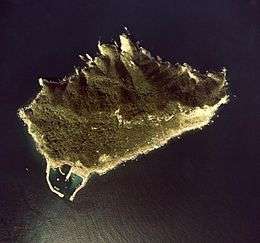Okinoshima (Fukuoka)
| Native name: 沖ノ島 | |
|---|---|
 | |
 Okinoshima Location in Japan | |
| Geography | |
| Location |
Sea of Japan East China Sea |
| Coordinates | 34°14′N 130°6′E / 34.233°N 130.100°E |
| Archipelago | Japanese archipelago |
| Administration | |
| Region | Kyushu |
| Prefecture | Fukuoka Prefecture |
| City | Munakata, Fukuoka |
| Demographics | |
| Population | 1 |
| Ethnic groups | Japanese |
| UNESCO World Heritage site | |
| Part of | Sacred Island of Okinoshima and Associated Sites in the Munakata Region |
| Criteria | Cultural: (ii), (iii) |
| Reference | 1535-001 |
| Inscription | 2017 (41st Session) |
| Area | 68.38 ha (169.0 acres) |
Okinoshima (沖ノ島 Okinoshima) is an island, part of the city of Munakata, Fukuoka, Japan. It is considered sacred land by the local Munakata Taisha. The island's population consists of a single employee of the shrine. He is one of about two dozen Shinto priests who spend 10-day intervals on the island, praying and guarding against intruders.[1]
The entire island is considered a shinto kami, and the island is off limits to women. For centuries, only 200 men were allowed on the island on one day each year after they had "purified" themselves in the surrounding sea.[1]
The island covers area of 97 ha (240 acres) and has maximum elevation of 244 m (801 ft).
Munakata Taisha Okitsu shrine
The Okitsu-gū shrine is located at the southwestern portion of Okinoshima. It was established in the mid 17th-century. Prior to the shrine's establishment as a sacred natural site, the surrounding site served as a location for the worship of the kami. The shrine has been maintained in relatively the same condition since the Shōwa period 1932, prior to which, it had undergone repair and rebuilding several times.
Legend
The island's deity was said to guard a popular trade route to Korea. In exchange for safe passage, fishermen provided offerings that included swords, flat-iron ingots, elaborate mirrors and bronze dragon heads. The offerings were concealed underneath stones or scattered between boulders.[1]
In the 1600s a Christian feudal lord, Kuroda Nagamasa, collected the offerings and put them in a tower of his castle. According to legend, the tower began to shake, bright objects streaked through the sky, and diseases plagued Nagamasa's people. Nagamasa returned the objects to the island, and the unsettling events stopped.[1]
Today many of the treasures are on display in the Munakata shrine on Kyushu.[1]
UNESCO Status
In 2009 the island was submitted for future inscription on the UNESCO World Heritage List as part of the serial nomination Okinoshima Island and Related Sites in Munakata Region.[2][3] The island gained status as a UNESCO World Heritage site on July 9, 2017. [4]
Local residents had expressed their worry that the island's inclusion on the UNESCO list would cause an increase of tourism that would threaten its sacredness. Takayuki Ashizu, the chief priest at Munakata Taisha, said that regardless whether or not Okinoshima is added to the UNESCO cultural heritage list they would not open it to the public because "people shouldn't visit out of curiosity."[5]
See also
References
- 1 2 3 4 5 Kaiman, Jonathan (8 December 2017). "A sacred Japanese island struggles secrecy and survival". The Los Angeles Times. Retrieved 8 December 2017.
- ↑ "Okinoshima Island and Related Sites in Munakata Region". UNESCO. Retrieved 15 June 2012.
- ↑ "Okinoshima Island and Related Sites in Munakata Region". World Heritage Promotion Committee of "Okinoshima Island and Related Sites in Munakata Region". Retrieved 15 June 2012.
- ↑ "Japan's Okinoshima islands gains Unesco World Heritage status". BBC News.
- ↑ Hashimoto, Ryo (January 12, 2016). "'Sacred' men-only Japanese island to make UNESCO bid, but locals fear tourism". The Japan Times.
External links
| Wikimedia Commons has media related to Okinoshima, Munakata. |
Coordinates: 34°14′42.31″N 130°6′19.20″E / 34.2450861°N 130.1053333°E
